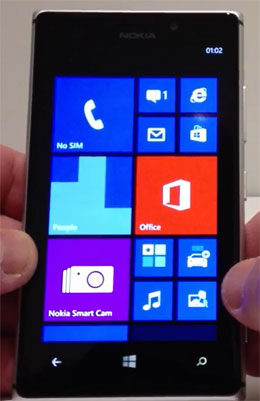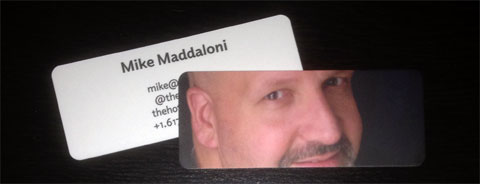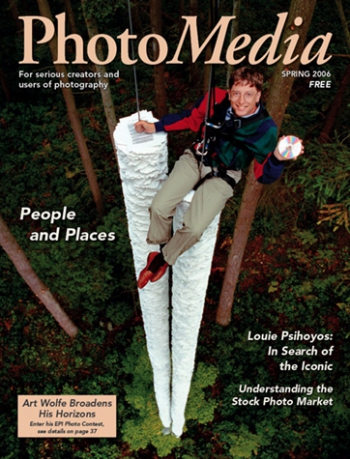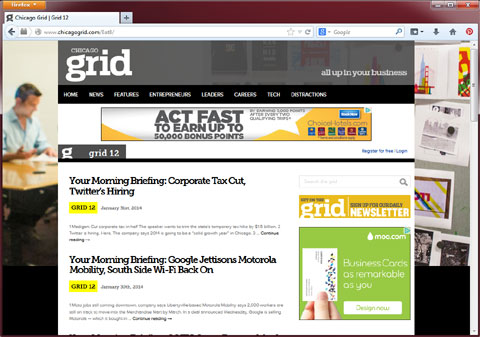3 Things New Microsoft CEO Satya Nadella Must Do To Win At #Mobile
 Earlier this week global software giant Microsoft named Satya Nadella as it’s 3rd-ever CEO, succeeding Steve Ballmer, who succeeded Bill Gates. Where the position is highly regarded, and the opportunity is immense, Nadella will have the challenge of defining what Microsoft will be going forward and especially what they won’t be. Some say the company is too big, rooted in its traditional PC and server operating system and software business while trying to be a consumer business with video game consoles and mobile devices.
Earlier this week global software giant Microsoft named Satya Nadella as it’s 3rd-ever CEO, succeeding Steve Ballmer, who succeeded Bill Gates. Where the position is highly regarded, and the opportunity is immense, Nadella will have the challenge of defining what Microsoft will be going forward and especially what they won’t be. Some say the company is too big, rooted in its traditional PC and server operating system and software business while trying to be a consumer business with video game consoles and mobile devices.
Where there are many opinions on where the company should be overall, one area I will be watching closely is how it moves forward with mobile technology. Its Windows Phone platform is a distant third after industry leading iOS from Apple and Android from Google. Even a close tie with former mobile industry leader Nokia didn’t prove to be a winning combination, which will be taken to the next level with Microsoft buying Nokia’s mobile division outright.
Can Microsoft be successful at mobile? I believe it can, and if it were up to me, I would follow these 3 major activities to not only succeed at mobile but to thrive and be a contender for the industry lead. Seriously! But as I am not in that role, I will share my ideas here, and Mr. Nadella is free to take them if he chooses. If you’re familiar with the novel A Christmas Carol by Charles Dickens, these 3 journeys are similar to those of Scrooge, dealing with the past, present and future.
First Reconnect With Your Corporate Roots
Where many know Microsoft as the people who built DOS and Windows for their PCs, the majority of their business is in running corporate computers and servers, and the additional software and consulting services that go with them. Where in 2014 many companies run Linux servers, for many years CIOs shied away from the open-source platform, relying on the operating systems from Microsoft, warts and all.
As Nadella previously led the cloud computing business at Microsoft, he knows how many corporate clients are moving much of their infrastructure to the cloud. He must also know that for as much as companies are looking to save shedding physical servers, they are now spending some of that on mobile devices, providing smart phones to their staff to keep them in contact and productive wherever they may be.
But have these mobile devices been Windows Phone devices? Some may have been, but there are probably still more BlackBerry devices in the hands of corporate users. And that number is probably dwindling, swinging towards iPhones and Android devices, which can integrate well with corporate email and are also popular platforms for the development of corporate apps, not to mention personal apps and Angry Birds.
In reconnecting with the corporate customers, mobile must be leading the conversation. What exactly is said depends on the following 2 activities in my plan.
Next Throw Money At Mobile Today
Yes, I said throw. Microsoft is well-known for its cash reserves in the billions. Where some of it is held for fighting legal challenges, some has been used for acquisitions, including Nokia’s mobile business. Where I don’t know exactly how much they have as of writing this post, I have heard it is anywhere around $50 to $60 Billion dollars.
So when I say throw, Microsoft needs to use its reserves to spend and better position itself right now in the mobile world, and fast. Over the past few years I witnessed Google do this with Android, going from nowhere to it being the second-largest mobile platform. They spent money on advertising, promotion, and on developers to build apps for Android devices. All of this for what is technically an “open-source” platform as well!
Microsoft’s Windows Phone operating system has a unique interface and personally I feel it is more robust than screens full of icons in iOS. Couple this with solid engineering and technology it acquired from Nokia, including it’s high-quality Zeiss lenses for its cameras, and you have a solid device that can be used by anyone. But do they know about it?
For Windows Phone to be successful it needs both marketing and buzz. There are plenty of agencies out there would love the opportunity to really sell the “experience” of Windows Phone, just as or even better than Apple has with the iPhone. For buzz, people need to hear about the features from their friends and family, and here Microsoft can tap into the agency that did this well for Nokia for years, 1000heads, as they are the leaders of word-of-mouth marketing and would love to bring back the raving fans they cultivated for Nokia in the past for Microsoft.
At the end of the day, it is really about what you can do with the mobile device, and what most people use is apps. Here’s an area where Windows Phone is way behind. Most app development is done either just for iOS or for Android, and in some cases is done just for iOS. Windows Phone is usually a distant third, if at all. This is an area where a large chunk of that Microsoft reserve money can come in handy. Both consumer and corporate apps are needed for the platform to thrive. Here is the tie in with the corporate relationships – give money, tools, support, consultants, devices… whatever is needed for corporate clients to build apps for the platform. Help them leverage technology like PhoneGap where they can build apps “once” and port them to each platform (I am streamlining a lot of technical detail, but that is the 50,000 foot view of it).With corporate apps, plus seamless integration with Microsoft Exchange mail servers, you have an employees empowered with a sleek device and all the tools they need to log their hours or whatever it is they need to do.
I did not gloss over consumer apps, as these are direly needed. When it was announced the social photo app Instagram was coming to Windows Phone, it was over a year and a half after it came out for Android. Looking at some of the top apps I use – Starbucks, Hailo taxi, the Weather Channel and MapMyRide for bike ride tracking, only the Weather Channel app is available for Windows Phone. The fact the Starbucks app is not on it is almost shocking, seeing the headquarters of Starbucks is only about 16 miles from the headquarters of Microsoft! And if the large corporate players are not building apps for Windows Phone, neither are the small start-ups. Here Microsoft needs to do what Google did before them and what I am suggesting they do for corporate clients – throw money at it, pay key app developers to port their apps to Windows Phone, hold developer conferences, buy developers free food and beer, give them free devices… all what they need to help bolster the Windows Phone Store so you won’t have to think about what apps are available for the platform, at all and never again.
Define The Future Of Mobile
What will mobile devices look and feel like a few years from now? 5 years from now? 10 years from now? Whatever the answer to the question is, Microsoft should be looking to be the one to answer it, and set the bar high for the rest of the industry to follow.
Hopefully among all of the chaos with Nokia over the last few years they have some of the brilliant hardware and software designers joining them as part of the acquisition to help define this. Where everything Nokia did was not always a top-selling device, they did create some interesting form factors, from fly-out keyboards to round devices to the small thin candy bar device. Today, with the lead from Apple and the close following from everyone else, including Nokia, everything looks like a black slab, and I know personally myself – and many others in the industry – are tired of black slabs! This is an area where Microsoft is not completely known for – amazing user experiences – but they have a start with Windows Phone, have some advances in their gaming devices and – with the right innovative leaders – create what is next, while not forgetting where it came from, as Nadella said in his first remarks as CEO.
No Time Like The Present
Right now is a good time to make moves in the mobile area for Microsoft. Apple is still feeling the loss of Steve Jobs and trying to define its next versions of devices and operating systems, with the last round not receiving the glowing praise it usually does. Google just unloaded Motorola to Lenovo and may be taking a different direction with hardware. Samsung keeps making bigger and bigger and bigger black slabs. And don’t forget BlackBerry, as they are still hanging on and trying to define what their future is while everyone else is digging their grave.
I wish Satya Nadella much luck and good fortune as he takes the helm at Microsoft. Having Bill Gates step down as Chairman and simply being an advisor was a great first move by Nadella. There is a lot to sort out and a lot to prioritize, but I personally see great opportunity with mobile, and Redmond taking the reins from Cupertino is not completely out of the question.
Go ahead – let me know what you think in the comments to this post.
This is from The Hot Iron, a journal on business and technology by Mike Maddaloni.
Did you enjoy this? Subscribe to The Hot Iron by RSS/XML feed or Read by Email.
Business • Mobile Technology • Technology • Thrive • (0) Comments • Permalink
What I Learned This Week For January 31 2014
Though a day late, hopefully you will find useful at least 1 thing I learned this past week, as collected on the back of a flyer for VHS to DVD media conversion.
- Though every media outlet and their grandmother in the Windy City reported on the demise of Chicago Grid by Wrapports, the publisher of the Chicago Sun-Times newspaper, nobody has noticed the Grid Web site is still up-and-running, at least in part. I only found this out as I was still subscribed to their RSS feed, and after several days a daily summary was again appearing. Though I shared this several times this past week with media outlets in the city via Twitter, nobody else seems to be talking about the ghost RSS feed or seems to care.
- If you read any book, especially children’s stories, through the lens of the late Dr. Sigmund Freud, you will never read one the same way again, or may not want to read one at all.
- When you use a service on a daily basis and never even think twice about its quality or reliability, that is not a good thing, that is a great thing. It also probably explains why I haven’t blogged about my great experience with Phone.com over the almost year I have been with them for my home phone service. I need to do something about that.
- Beverly Hills, California got its name from Beverly, Massachusetts, namely its Beverly Farms section. Now I have been to both communities, and I couldn’t think of any 2 places that could be further opposites of each other.
- When I tell people I am from Massachusetts, the next thing they say is that I don’t have a Boston accent. When I go onto explain to them my roots are in the western part of the state, where they use all 26 letters of the alphabet and put them in the right place. For as many times as I state that, it really doesn’t resonate with people, so I thought I’d let the good Dr. Westchesterson explain it better than I possibly could with his video Western Mass. – it is embedded below or watch it on YouTube. I can’t think of a better way to end one month and begin another!
This is from The Hot Iron, a journal on business and technology by Mike Maddaloni.
Did you enjoy this? Subscribe to The Hot Iron by RSS/XML feed or Read by Email
Blogging • Business • Thrive • Web Development • What I Learned • (0) Comments • PermalinkFinally Ordered Personal MOO MiniCards
So I got me some of those MOO MiniCards.

When it comes to business cards, some people always carry and offer them, others feel it’s 2014 so we should just digitally connect only, and probably the majority of the people out there are indifferent to them. As someone who is of the first group, I try to always carry cards with me, as you never know who you will connect with and where.
As the name goes, they are business cards, and those cards are all, well, business. It has my business title, phone, email, etc. It doesn’t list my blog, my Twitter account, or have other identifying information about me, personally. So if I meet someone personally and want them to reach me personally – or the converse for business – shouldn’t I have separate cards for that?
That was my thinking when I ordered MOO MiniCards. Now these slim cards – which measure 2.75” x 1.10” (or 70mm x 28mm) – are nothing new, and I began getting them from people as far back as 2008, and maybe even earlier. I felt these cards would be perfect to share the basic info I want to offer to someone, as well as the best identifying information about me, my face. Someone doesn’t need my home address when they first meet me, and if they want to send me a Christmas card, they have my email address to ask me for it. I also thought it would be a good idea to get MOO cards before I turned 50.
In the past I used to carry personal business cards, even before the days of free business cards from the likes of VistaPrint came along. But that was also in the 1990’s, when texting someone your contact information was not an option, for most likely the person you met didn’t have a cellular phone.
For full-color, good stock cards MOO MiniCards are affordable. You can get 200 cards, full-color and double-sided printing, for under US$40. I also chose the optional rounded corners. You design and order the cards through their easy-to-use Web site at moo.com. Of course you can find an online coupon code or get on their email list for specials. They sent me a coupon code with my order – 2RB2CK – for 15% off. I don’t get anything if you order, that is unless you give me one of your cards.
So did I convince you to also get MOO MiniCards? Do you already have them? Do you think they are not worth it, or are you indifferent? I welcome your thoughts in the comments to this post.
This is from The Hot Iron, a journal on business and technology by Mike Maddaloni.
Did you enjoy this? Subscribe to The Hot Iron by RSS/XML feed or Read by Email.
Business • Social Media • Thrive • (2) Comments • Permalink
What I Learned This Week For January 24 2014
 This week a piece of Syracuse University notepad paper hosted the eclectic list of things I learned throughout the last 7 days. Special thanks to my cousin Fedora for the notepad, and away we go.
This week a piece of Syracuse University notepad paper hosted the eclectic list of things I learned throughout the last 7 days. Special thanks to my cousin Fedora for the notepad, and away we go.
- Clearly I am not the only one having problems with the Cardmunch app from LinkedIn. This is evident from blog posts like this one and numerous threads in their support forum.
- Though Ron May may no longer be of this mortal coil, his eponymous Chicago tech news site The May Report lives on, now under the guidance of his brother Paul. And they have an RSS feed.
- Last week I mentioned about Jason Jacobsohn’s Chicagoland Entrepreneur Events newsletter, which is a bonus for signing up for his main newsletter. Follow the preceding link and you can subscribe to it directly, though you really will want to read both of them.
- Living in Chicago made it hard to not hear about the story of Vivian Mayer, whose amazing talent for photography was only found after she defaulted on payments for a storage unit and her subsequent death. That being said, I had never really experienced her work up until that past weekend when I saw an exhibit on her at the Chicago History Museum - simply amazing.
- There are a number of blogs who could benefit from having a CentUp button on their site. And when I say benefit, I mean earn money from readers.
- Though past performance may be the best indicator of future performance, there is certainly no guarantee of it. This I learned the hard way when my New England Patriots lost the AFC Championship game and will not be going to the Super Bowl next week. Thanks for an awesome season, though.
- I was talking with a colleague about hard drive storage and the accompanying picture of a magazine cover from PhotoMedia Magazine from Spring, 2006 came to mind. As she hadn’t heard about it, I searched it down – I did not recall the name of the publication only the photo itself – and found it, and thought someone may have missed it too.
- Sears is closing its State Street, Chicago store. As someone who lives so close to it, the store was not a regular shopping trip, but we made many household purchases there, had some awesome photos taken of our kids before the portrait studio was shuddered, and bought the outfits my kids wore home from the hospital after they were born. Sears was also upfront on Twitter when I tweeted about the closing, kudos on this.
- The Commonwealth of Massachusetts – my home state – blocked the sale of Apple stock to its residents when they went public. I learned this from Jonathan Hoenig when I included him on a tweet thread about crowdfunding and risk with Len and Griffin.
- If the windshield of your 2013 Honda Odyssey is covered with snow, make sure to close the driver’s side door before you turn on the wipers.
- In keeping with a new closing video theme… I learned that as many times as you see the Too Hot To Handel concert it never gets old, and this past weekend was my 7th time. What is it? Watch this video on YouTube or watch it embedded below.
This is from The Hot Iron, a journal on business and technology by Mike Maddaloni.
Did you enjoy this? Subscribe to The Hot Iron by RSS/XML feed or Read by Email
Blogging • Business • Technology • Thrive • What I Learned • (0) Comments • PermalinkThe Lack Of Women In Technology And Why I Don’t Touch Type

There has been a lot of talk and activity about encouraging more young women to enter the technology fields, whether engineering or software or any technical role. Much of the reason for the outside effort is that girls and young women are not typically encouraged to enter these fields.
When I first started hearing about these kind of efforts, I was initially surprised, namely as I have had the good fortune to work with many women over the years in software development and Web technology. Where when many think of the traditional “geek” it is a guy, there have been many women I would also consider geeks, and if I told them to their face, they would probably agree with me!
Perhaps maybe I am an anomaly, for as I pull back and see the big picture, I do see there are many more men in tech, whether it’s in the leadership within a company or within the industry overall. I haven’t studied this area in great detail as to statistics or even why there may be people discouraging women from getting into technology. For the more I think about it, I am not surprised that teachers, guidance counselors or even parents or family may discourage someone from taking classes in a subject area, as this was something I encountered myself.
I Don’t Know How to Touch Type
All that you are reading here, including the infrastructure and front-end code that presents my writings here on The Hot Iron, were entered into a keyboard with just my index fingers, plus my thumbs on the spacebar. Seriously, I don’t know how to touch type, and not only did I never take a class in high school to learn how to, but I was encouraged not to.
Though I was using computers back in junior high school, had my own computer at home and even did my first consulting gig for the assistant superintendent of my school system plus it was overall no secret I was into computers, the fact I should probably learn to touch type did not come naturally to my guidance counselors in high school. Their reasoning? As I was on the “college track” in high school, this was not a recommended course to take, and typing – which was offered in school – was encouraged for those not going into college and rather right into the workforce. Seriously, that was the thinking in the early 1980’s. I never did fight this, for by that point I had been typing this way for several years now.
Don’t get me wrong, this is not anything that has ever haunted me as a decision. I have managed to get by with just 40% of my digits on the keyboard and I am actually quite quick at typing this way. The reason why I remember this is because people, upon watching me type, will always ask me why I don’t touch type. As the question comes up almost as frequently as to why I sign my email messages as I do, it is a story that is readily accessible. Over the years I could have taken a typing class but never even made an effort to do so, as I am not sure how much different it would have made. Of course I am not saying this “guidance” led me down a different path, but it is a small example of the types of influences that are out there.
Expose To Most All, Let Them Decide
The more I think of this effort, the more I believe in it. As a parent, I don’t want to purposely hold back my kids from any career or activity decision, providing I can afford it. Though this is nothing I am worried about now, for right now my oldest first needs to learn to read, and my youngest needs to finish potty training! But by the time they are older, hopefully there won’t be a need for organizations like Ms. Tech and the many others, for opportunities will be chosen based on your interest, not negative outside influences.
I welcome you to share any stories – positive or negative or even anecdotal – on this subject in the comments to this post.
This is from The Hot Iron, a journal on business and technology by Mike Maddaloni.
Did you enjoy this? Subscribe to The Hot Iron by RSS/XML feed or Read by Email.
Strategize • Technology • Thrive • (4) Comments • Permalink




